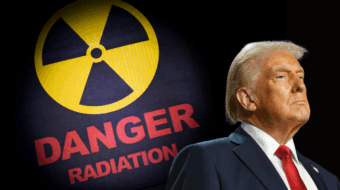The bankruptcy of Solyndra, a solar company that received a federal loan guarantee, has made the front page because of charges of cronyism. But among the biggest risks to taxpayers, who underwrite federal loan guarantees, isn’t renewable energy. It is nuclear power.
The Department of Energy declared its intent to conditionally issue a loan guarantee of $8.33 billion to Georgia Power and its utility partners in February 2010. Why should taxpayers be concerned? Congress and the DOE are ignoring the sordid history of nuclear power plant construction and bailouts, recent developments in nuclear plant construction, and the low-balled cost of Georgia Power’s proposed additions.
The initial wave of nuclear plant construction cost ratepayers $200 billion in cost overruns. Abandoned plants cost the public $50 billion. Because the finished plants were not the least cost resource, it is estimated that by the mid-2000s, ratepayers had paid $225 billion in excess charges. The deregulation scam in the late 1990s saw the public picking up $40 billion in stranded costs for the nuclear industry. The bailout came in the wake of industry whining about not being able to compete in deregulated markets. Since 2003, various cost estimates for nuclear power rose from about $2,000 per kilowatt to $6,000 or $7,000 per kilowatt.
Forbes magazine in 1985 called nuclear power the “worst managerial disaster in history.” The Economist in 2001 declared nuclear power “too expensive to matter.” Moody’s in 2009 viewed “nuclear generation plants as a ‘bet the farm’ endeavor for most companies … .” After multiple cancellations and delays of nuclear plants, an analyst for the Institute for Energy and Environment said, “2009 was the seventh year of the so-called ‘Nuclear Renaissance,’ but it looks a lot like the U.S. nuclear industry of the 1980s, a decade of no new orders, multiple delays and cancellations, hefty defaults and emerging cheaper alternatives.”
Government warned us, too. In 2003, the Congressional Budget Office considered “the risk of default on [nuclear loan guarantees] to be very high – well above 50 percent.” And this was before surging costs and a devastating economic crisis.
These facts and a near, if not actual, depression have not deterred the DOE or Congress’ enthusiasm for nuclear power in its bid to bail out the industry once again with public dollars. But nuclear power remains the most expensive and dangerous way to boil water to create electricity. The excessive time horizon needed to plan, design and build a unit makes it overly expensive and unable to compete with other energy resources, such as energy efficiency, wind or solar.
Yes, solar panels are now cheaper than nuclear power. All of these alternatives are cheaper and can be deployed more quickly than nuclear power, which means they can reduce carbon emissions much more quickly as well. Moreover, restraints on supply chain and expertise make an extensive build out in the U.S. impossible to achieve. And we can’t operate them without periodic disasters – e.g., Three Mile Island, Chernobyl and Fukushima.
Now is no different than 30 years ago. The French, considered the nuclear experts in the West, are having the same difficulties of cost overruns and delays at its nuclear plant construction site in Finland. Progress Energy’s proposed nuclear plant in Florida, of the same design as the French and Georgia Power proposal, went from an estimated $2.5-$3.5 billion in 2006 to more than $22 billion in 2010. And they’ve barely turned a spade of dirt.
Georgia Power estimated $14 billion for its Vogtle plant in 2006 and has not revised the estimate. Indeed, they are withholding new cost estimates as confidential information. It hopes to have its construction and operating permit by the end of 2011. A recent analysis of the plant estimated the mid-range cost of the units at $10,775 per kilowatt. This would put the cost of the plant at $24 billion. The DOE is recklessly forging ahead with support for the new nuclear units in Georgia without knowing the ultimate cost and exposure to taxpayers, yet being familiar with nuclear power’s disastrous financial history.
Defining smart use of public funds to advance a safe, secure and clean energy future for the country is the right debate. The executive and legislative branch’s continuing investment of taxpayer money in nuclear power should be the subject of investigations and public scrutiny.
Solo is president and founder of the nonprofit and nonpartisan Civil Society Institute and facilitator of the Citizens Lead for Energy Action Now. Smith is a senior energy policy analyst to the Civil Society Institute and former executive director of the Citizens Action Coalition of Indiana, where he worked for 29 years. This article is distributed by the American Forum.










